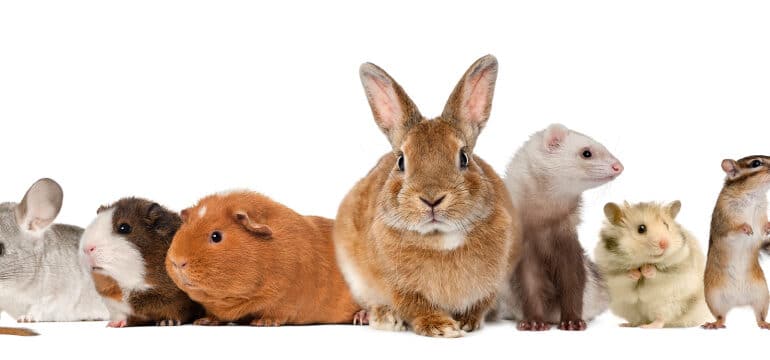The smallest furry friends sometimes make the largest impact, and nothing could be more true of the variety-filled class of animals known as pocket pets. From gerbils to hamsters to rabbits and everything in between, these tiny pets have unique characteristics and traits completely different from, but equally as lovable as, their fellow larger pets. Let’s take a look at what makes them special.

Pet gerbils are gentle and hardy animals, which originated in Mongolia and were brought to the United States in 1956, where they became household pets. These pint-sized pets weigh an average of 2.5 ounces, and are social animals who prefer to live in groups in the wild. Gerbil habitats vary from those of hamsters, rats, and mice, in that they need to be able to dig tunnels rather than having plastic ones created for them. An interesting trait of gerbils is a behavior called “thumping” in which they pound both hind legs on the ground when they are excited or stressed, or to attract a mate!

One of the most popular types of pocket pets, hamsters are wonderful pets who can range from just 2 inches to 13 inches long depending on the breed. There are five different hamster species that are usually kept as pets: Syrian, Roborovski, Campbell’s Dwarf, Chinese, and Winter White Russian Dwarf. They typically have around 7 pups in a litter, but some litters have been known to have up to 24 pups! Hamsters are short-lived pets with an average lifespan of 2½ years, but can live up to 4 years. As any hamster lover knows, these pint-sized pets are packrats and store food in their cheeks in order to move it to a safe place to eat, sometimes even doubling or tripling their head size with their gatherings!

Fancy rats & mice look quite similar, but are quite different in size and demeanor. Mice are more similar to hamsters in that they prefer to do their own thing most of the day, while rats are sometimes thought of as “little dogs” who typically love to socialize with their humans. Rats are also very smart, being able to learn many tricks if trained properly! Both fancy rats & mice have been exhibited for over 100 years, with the National Mouse Club of Britain having been formed in 1895.

Despite their name, guinea pigs bear no relation to actual pigs and did not originate in Guinea; they actually belong to the rodent family and came from the Andes! Once they come to know and trust their owners, they are very affectionate and enjoy regular interaction. Guinea pigs are extremely clean, and love to spend long amounts of time grooming themselves and others. A few interesting facts about guinea pigs are that they are unable to manufacture Vitamin C, so it must be supplemented through their diet, and that their teeth grow throughout their lifetime, which makes it extremely important for them to have something to gnaw on to wear their teeth down.

The spiniest of pocket pets, the hedgehog has been around for over 15 million years. These prickly pets have between 5,000 and 7,000 quills, however unlike porcupines their quills are not barbed or poisonous. Hedgehogs tend to be fearful of people, and need extra attention and loving care to thrive with their human companions. They are also immune to most types of snake venom, and the subject of a lesser-known Brothers Grimm fairytale called “Hans My Hedgehog”!

Adorable, fluffy chinchillas may be the softest of pocket pets, and they require experienced pet owners for their special needs. They lack the ability to regulate their body temperature, and therefore need to be kept in environments of 60-70 degrees at all times. Chinchillas clean their fur by taking dust baths, a process of cleaning their fur by rolling around in a special dust of fine pumice. If they get wet, their fur may grow a fungus, or it could lead to a skin infection. Interestingly, chinchillas can also “see,” or rather feel, with their whiskers, because their eyes are underdeveloped, and they are phenomenal acrobats with the ability to jump about 6 feet from high places!

True to their name, sugar gliders can glide over 150 feet! They are part of the marsupial family, like kangaroos, and female sugar gliders raise their babies in a pouch on their belly for a few months after they are born. Male sugar gliders can also go bald (it’s really a bare spot where they have a scent gland on their head). Sugar gliders form permanent bonds with their human families and are very intelligent; they can learn their name and do tricks with proper training.

Ferrets are about as ancient as pocket pets come; in fact, depictions of pet ferrets on leashes have even been found on some Egyptian tombs. The average ferret can live to be 6 to 7 years old, and they uniquely have no inherent fear of humans. Another interesting fact about ferrets is that they can sleep so soundly that they cannot be woken up, even when picked up and jostled!

A wonderful pocket pet, rabbits are very sociable and love attention from their owners! They are intelligent and inquisitive, and can be litterbox trained. When their housing is maintained properly, they are also nearly odorless. Pet rabbits should have plenty of social interaction and exercise; they also need entertainment and stimulation, to keep them from becoming bored and chewing on household items.
Since your pocket pet is a unique pet, they need unique care. We have a special interest in pocket pets unique to the region, and are happy to answer any questions you may have about these pint-sized pets – make your appointment today online or by calling 701.757.3500.


